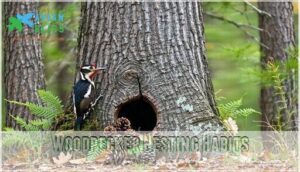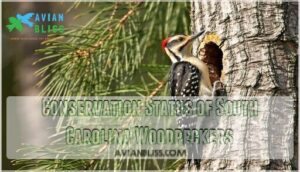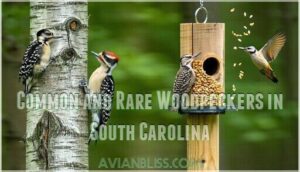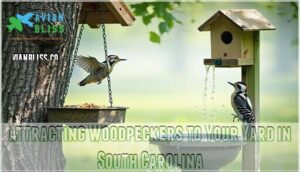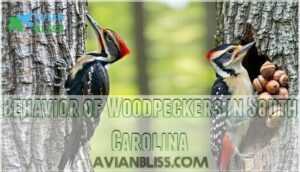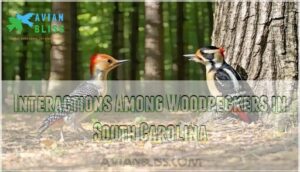This site is supported by our readers. We may earn a commission, at no cost to you, if you purchase through links.
 You’ll find eight to nine woodpecker species in South Carolina, from the diminutive 0.8-ounce Downy Woodpecker to the impressive 10.5-ounce Pileated Woodpecker.
You’ll find eight to nine woodpecker species in South Carolina, from the diminutive 0.8-ounce Downy Woodpecker to the impressive 10.5-ounce Pileated Woodpecker.
This woodpeckers South Carolina guide covers year-round residents like Red-bellied and Downy Woodpeckers, plus seasonal visitors such as Yellow-bellied Sapsuckers.
These cavity-nesting birds excavate holes in 2-3 weeks, with clutches ranging from 2-10 eggs.
They’re divided into three feeding groups: bark drillers hunting beetles and larvae, ground foragers like Northern Flickers targeting ants, and sap specialists creating wells for tree sap.
The endangered Red-cockaded Woodpecker requires special conservation attention.
Understanding their unique calls, behaviors, and habitat preferences will transform your backyard bird-watching experience.
Table Of Contents
- Key Takeaways
- Woodpeckers in South Carolina: Overview
- Size Difference Among South Carolina Woodpeckers
- Woodpecker Nesting Habits
- Woodpecker Diet in South Carolina
- Conservation Status of South Carolina Woodpeckers
- Identifying Calls of South Carolina Woodpeckers
- Common and Rare Woodpeckers in South Carolina
- Attracting Woodpeckers to Your Yard in South Carolina
- Behavior of Woodpeckers in South Carolina
- Interactions Among Woodpeckers in South Carolina
- Frequently Asked Questions (FAQs)
- Are woodpeckers protected in SC?
- What month are woodpeckers most active?
- What’s the biggest woodpecker in South Carolina?
- Is it good to have woodpeckers in your yard?
- What months are woodpeckers most active?
- Is it rare to see two woodpeckers together?
- What are the different species of woodpeckers in South Carolina?
- How do woodpeckers diets vary?
- How do woodpeckers breed?
- How do I identify a woodpecker by its call?
- Conclusion
Key Takeaways
- You’ll find 8-9 woodpecker species in South Carolina ranging from the tiny 0.8-ounce Downy Woodpecker to the massive 10.5-ounce Pileated Woodpecker, with most being year-round residents except seasonal visitors like Yellow-bellied Sapsuckers.
- You can attract woodpeckers to your yard by providing suet feeders, shallow water sources, native trees like oak and pine, and nesting boxes placed 8-20 feet high with 2-inch entry holes.
- You’ll recognize woodpeckers by their distinct calls and sounds – Red-bellied make rolling "churr" sounds, Downy emit soft "pik" notes, Pileated produce loud "kuk-kuk-kuk" series, and Northern Flickers give ringing "wick-a-wick-a-wick" calls.
- You should know that the Red-cockaded Woodpecker is federally endangered and requires special conservation attention, while Red-headed Woodpeckers have declined 70% since 1966, making habitat preservation crucial for these species’ survival.
Woodpeckers in South Carolina: Overview
Throughout South Carolina’s diverse landscapes, you’ll discover eight to nine woodpecker species that showcase remarkable species diversity and unique habitat preferences.
These birds range from the tiny Downy Woodpecker to the crow-sized Pileated Woodpecker, each adapted to specific environments.
Common woodpeckers SC residents encounter year-round include Red-bellied and Downy species, while seasonal presence varies with migrants like Yellow-bellied Sapsuckers.
Identification challenges arise from similar plumage patterns, but understanding their distinct behaviors helps with woodpecker identification SC.
The conservation importance of these SC birdwatching woodpeckers can’t be overstated, especially for endangered species like the Red-cockaded Woodpecker.
North Carolina, by comparison, hosts eight distinct species.
Size Difference Among South Carolina Woodpeckers
South Carolina woodpeckers show dramatic proportional differences in size.
Weight comparison reveals striking variations among species:
- Downy Woodpecker – At 0.8 ounces, it’s the smallest with compact proportions perfect for traversing thin branches
- Medium species – Red-bellied, Red-headed, and Hairy Woodpeckers weigh 2-3 ounces with moderate length variation
- Northern Flicker – Reaches 4-5 ounces with distinctive ground-foraging build
- Pileated Woodpecker – The giant at 10.5 ounces, showing impressive sexual dimorphism in crest size
This woodpecker size comparison helps with woodpecker identification SC.
Habitat loss is a threat to many woodpecker species. Juvenile sizes typically match adults by fledging, making length variation a reliable field mark for common woodpeckers SC identification year-round.
Woodpecker Nesting Habits
Woodpeckers’ nesting prowess reveals fascinating architectural skills that’ll amaze any backyard observer.
Cavity excavation takes 2-3 weeks for most species, with both parents chiseling perfectly sized holes in dead wood.
The red-cockaded woodpecker breaks this rule, requiring up to a year to excavate cavities in living pine trees.
Unlike other woodpeckers that excavate quickly, red-cockaded woodpeckers spend up to a year crafting their living pine sanctuaries
Clutch size varies dramatically across species, from 2-10 eggs per brood.
Parents share egg incubation duties during daylight, but males handle nighttime shifts exclusively.
This parental care continues for 9-14 days until hatching.
| Nesting Aspect | Details |
|---|---|
| Excavation Time | 2-3 weeks (most species) |
| Incubation Period | 9-14 days with shared duties |
| Cavity Reuse | Rare, except red-cockaded |
Most species abandon their woodpecker cavities after one season, but red-cockaded woodpeckers practice nest reuse for both breeding and roosting.
Pair bonding promotes stability in woodpeckers, especially those that mate for life.
These woodpecker nesting habits create essential habitat for cavity-dependent wildlife throughout South Carolina’s forests.
Woodpecker Diet in South Carolina
The woodpecker diet in South Carolina reveals fascinating dietary adaptations across different species. Most woodpeckers here fall into three main foraging groups with distinct feeding strategies.
Typical woodpeckers like Red-bellied and Hairy Woodpeckers rely heavily on insect consumption, drilling through bark to find beetles, ant larvae, and caterpillars. Their specialized foraging techniques include peeling bark and excavating wood to reach hidden protein sources.
Northern Flickers take a different approach, specializing in ground foraging for ants and ant larvae at soil colonies. Meanwhile, Yellow-bellied Sapsuckers show unique sap dependence, drilling neat rows of holes to access tree sap and trapped insects.
Seasonal foods play important roles too. Red-headed Woodpeckers catch insects mid-flight during warmer months, while Red-bellied Woodpeckers store nuts and berries in tree crevices for winter. These common woodpeckers SC residents have evolved diverse woodpecker food sources strategies, from ground specialists to aerial hunters, making South Carolina’s woodpecker foraging behaviors remarkably varied. Supplementing their diet with high-energy suet can be particularly beneficial during colder months.
Conservation Status of South Carolina Woodpeckers
Looking beyond their feeding habits, you’ll find South Carolina’s woodpeckers face serious conservation challenges.
The Red-cockaded Woodpecker remains federally listed as an Endangered Species, while Red-headed Woodpeckers show concerning Population Trends with annual declines of 2.5% in some counties.
Red-cockaded Woodpeckers face extinction while Red-headed species decline by 2.5% annually in South Carolina counties
South Carolina’s woodpecker populations face a conservation crisis, with some species declining by 70% since 1966.
The avian plumage patterns aid in identifying different species.
Key conservation challenges include:
- Habitat Loss from deforestation and urban development
- Fire suppression disrupting longleaf pine ecosystems
- Competition from invasive species for nesting sites
- Pesticide use reducing insect food sources.
Conservation Efforts are making a difference through artificial cavity programs and controlled burns.
Landowner Programs like Safe Harbor partnerships help private property owners restore suitable habitat, supporting woodpecker conservation across the state.
Identifying Calls of South Carolina Woodpeckers
Learning to identify woodpecker calls transforms your bird-watching experience from guessing games into confident recognition. Each species produces distinct call characteristics that serve as reliable identification markers.
The Red-bellied Woodpecker uses a rolling, shrill "churr" call that’s often repeated, making it easy to spot at feeders. Downy Woodpeckers emit soft "pik" notes and descending whinnies—perfect for beginners learning species-specific sounds.
The Pileated Woodpecker produces unmistakable loud "kuk-kuk-kuk" series that echo through forests, while Northern Flickers deliver ringing "wick-a-wick-a-wick" calls.
Hairy Woodpeckers give sharper, louder "peek" calls compared to Downys. Red-cockaded Woodpeckers make distinctive raspy "sklit" notes that help identify this threatened species.
Vocalization variations increase during spring breeding season, with drumming peaking in early morning and late afternoon. Rain and wind reduce calling intensity, so ideal acoustic monitoring happens on calm days.
Mobile apps now provide verified call samples for all South Carolina species, supporting soundscape ecology research and citizen science efforts. Understanding the beak shape and size can also provide clues, as it correlates with their foraging techniques and the sounds they produce while feeding.
Common and Rare Woodpeckers in South Carolina
Across South Carolina’s diverse landscapes, you’ll find eight distinct woodpecker species thriving in different environments, though their abundance varies dramatically.
The Downy Woodpecker leads as the most widespread species, appearing in all counties and adapting well to various bird habitats in South Carolina. Species Distribution shows the Red-bellied Woodpecker ranking as the most common overall, frequently visiting backyard feeders and urban areas.
However, Population Trends reveal concerning declines for some species. The Red-headed Woodpecker has experienced a 70% population drop since 1966, making woodpecker identification in South Carolina increasingly challenging for this once-common species.
The Red-cockaded Woodpecker faces the greatest threat, occupying less than 1% of its historical range and remaining federally endangered despite Conservation Successes on public lands. To aid nesting success, artificial cavities can be installed.
Habitat Preferences play a vital role in distribution patterns. While Pileated Woodpeckers maintain stable populations in mature forests, the rare Red-cockaded requires specific longleaf pine savannas.
Identification Challenges arise because habitat loss continues affecting birdwatching in South Carolina opportunities, particularly for observing declining species.
Attracting Woodpeckers to Your Yard in South Carolina
Your backyard can become a woodpecker paradise with the right setup.
These fascinating birds need three essentials: food, water, and shelter to thrive in South Carolina’s diverse landscapes.
- Suet feeders attached to tree trunks attract up to seven species, including red-bellied and downy woodpeckers year-round
- Native trees like oak, pine, and hickory provide natural insect habitats and nesting opportunities for woodpecker backyard SC visitors
- Water sources such as shallow birdbaths with drippers create drinking and bathing spots that woodpeckers can’t resist
- Nesting boxes with 2-inch entry holes placed 8-20 feet high mimic natural cavities for successful woodpecker habitat SC
- Insect habitats flourish when you avoid pesticides, maintaining the diverse bug populations essential for woodpecker diet SC success
Creating these conditions transforms your yard into prime birdwatching in South Carolina territory.
Consider planting native trees to further encourage woodpeckers.
Behavior of Woodpeckers in South Carolina
South Carolina’s woodpecker behavior reveals remarkable adaptations that’ll captivate any bird enthusiast. These bird species exhibit distinct Social Behavior patterns, from the Red-cockaded Woodpecker’s cooperative family groups to the more solitary habits of Downy Woodpeckers.
Drumming Communication serves as their primary language—you’ll hear rapid-fire percussion echoing through forests as males establish territories and attract mates. Each woodpecker species in South Carolina has unique rhythmic patterns that experienced birders can identify by sound alone.
Territorial Displays involve aggressive posturing, with birds spreading their wings and raising head feathers when defending prime real estate. Foraging Strategies vary dramatically: Red-bellied Woodpeckers cache acorns in bark crevices, while Northern Flickers specialize in ground-level ant hunting. The Pileated Woodpecker’s size is the largest of the species.
Migration Patterns affect only Yellow-bellied Sapsuckers, which arrive each winter. This bird behavior in South Carolina demonstrates how different species have evolved specialized survival techniques.
Interactions Among Woodpeckers in South Carolina
Through the lens of ecology, interactions among South Carolina’s woodpecker species reveal complex social dynamics that’ll surprise you.
These birds engage in fierce territorial battles, cooperative behaviors, and resource sharing that shapes their survival strategies.
Understanding woodpecker behavior in South Carolina involves recognizing four key interaction patterns:
- Interspecies Competition – Red-bellied and Red-headed woodpeckers battle over prime dead tree trunks, with larger species like Pileated Woodpeckers dominating smaller ones during nesting season.
- Territory Defense – Woodpecker species in South Carolina use drumming, chasing, and physical confrontations to protect feeding and nesting sites, especially when cavity sites become scarce.
- Resource Partitioning – Downy Woodpeckers forage on thin branches while Hairy Woodpeckers work larger trunks, reducing direct competition through spatial separation.
- Social Hierarchy – Dominant woodpeckers occupy the best territories with abundant resources, while subordinate birds settle for marginal habitats.
This woodpecker ecology creates a delicate balance where cooperative breeding and competitive behaviors coexist in South Carolina’s forests.
Habitat loss presents significant conservation challenges for these species.
Frequently Asked Questions (FAQs)
Are woodpeckers protected in SC?
South Carolina protects one of nine woodpecker species under federal law.
You’ll find the Red-cockaded Woodpecker is federally threatened, making it illegal to harm them or their nests.
Other species aren’t specifically protected.
What month are woodpeckers most active?
You’ll spot peak activity during spring breeding season (March-May) when they’re drumming, calling, and excavating nest cavities. Early morning hours offer your best viewing opportunities year-round.
What’s the biggest woodpecker in South Carolina?
You’ll love spotting the majestic Pileated Woodpecker—it’s South Carolina’s heavyweight champion at 5 ounces! These crow-sized giants sport striking red crests and excavate rectangular holes in dead trees.
Is it good to have woodpeckers in your yard?
Yes, you’ll benefit from having woodpeckers in your yard.
They’re natural pest controllers, eating insects that damage trees and gardens.
They’ll help control beetles, ants, and larvae while adding wildlife interest to your outdoor space.
What months are woodpeckers most active?
Woodpeckers are most active during spring breeding season (March-June) and early fall migration (September-October).
You’ll notice increased drumming, calling, and foraging behavior during these peak periods when they’re establishing territories and preparing for seasonal changes.
Is it rare to see two woodpeckers together?
Like birds of a feather flocking together, seeing two woodpeckers isn’t particularly rare.
You’ll often spot mated pairs during breeding season, family groups with juveniles, or multiple species sharing good feeding spots around your yard.
What are the different species of woodpeckers in South Carolina?
South Carolina hosts eight woodpecker species: Downy, Hairy, Red-bellied, Red-headed, Pileated, Northern Flicker, Red-cockaded, and Yellow-bellied Sapsucker. You’ll find most year-round, though sapsuckers visit seasonally from northern regions.
How do woodpeckers diets vary?
Diet preferences divide South Carolina’s woodpeckers into three main groups: typical woodpeckers drill for insects and beetle larvae.
Flickers specialize in ground-dwelling ants, while sapsuckers create wells to harvest tree sap and trapped insects.
How do woodpeckers breed?
During breeding season, you’ll find woodpeckers excavating fresh cavities in dead wood, though Red-cockaded Woodpeckers uniquely choose living pine trees. Both parents share incubation duties for nine to fourteen days.
How do I identify a woodpecker by its call?
Ever wonder what that drumming sound is?
You can identify woodpeckers by their unique calls: drums on trees create rhythmic patterns, vocalizations include rattles, chatters, and "keek" sounds, while each species has distinct frequency and timing signatures.
Conclusion
Armed with this thorough woodpeckers South Carolina guide, you’re now equipped to identify these fascinating cavity-nesters throughout the Palmetto State.
From the tiny Downy’s gentle tapping to the Pileated’s thunderous drumming, each species offers unique rewards for patient observers.
Remember that creating woodpecker-friendly habitats benefits entire ecosystems while providing endless entertainment in your own backyard.
Start listening, watching, and discovering the remarkable world of South Carolina’s woodpeckers today, and enjoy the entire ecosystems benefits.


